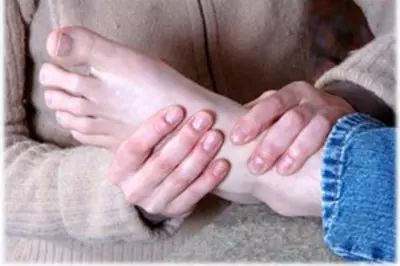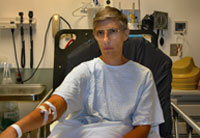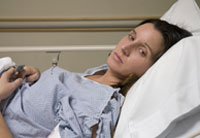Reflexology

How Can Reflexology Help My Health and Healing?
Reflexology may be beneficial in restoring balance and harmony in the body and releasing tension. Practitioners believe that it helps facilitate a deep state of relaxation, calm the emotions, and produce a serene mind. Research studies support many of these benefits.
Many people describe a profound sense of relaxation and increased energy following their session. In addition, specific studies indicate that reflexology may reduce pain and anxiety.
Reflexology can improve work outcomes
Reflexology is growing increasingly popular across Europe and Asia as both a complement to other treatments and as a preventive measure. One example is Denmark, where various municipalities and companies have employed reflexologists since the early '90s.
According to several studies, this practice in Denmark has resulted in reduced sick leave and absenteeism (and significant economic savings for the employers). Employees have consistently reported complete or partial improvement in conditions where they sought reflexologists' help and even relief for additional problems related to stress. In one municipal district, almost one-third of the employees reported greater satisfaction with their jobs after completing six sessions with a reflexologist.
Tom’s story: Chemotherapy-induced nausea
 I was in the hospital undergoing chemotherapy for cancer. Despite taking anti-nausea drugs, I felt constantly on the verge of vomiting. In fact, when my hospital reflexology therapist showed up for my session, I was about to throw up. But after asking my permission, the practitioner calmly performed a complete reflexology session on my feet, focusing on areas that corresponded to my stomach, intestine, and colon.
I was in the hospital undergoing chemotherapy for cancer. Despite taking anti-nausea drugs, I felt constantly on the verge of vomiting. In fact, when my hospital reflexology therapist showed up for my session, I was about to throw up. But after asking my permission, the practitioner calmly performed a complete reflexology session on my feet, focusing on areas that corresponded to my stomach, intestine, and colon.
After 30 minutes, my nausea dropped from a 10 in severity to a 2, and I no longer needed to vomit. My nurse came in to give me nausea medication on time, but I told her I didn't need it.
“Overall, I just felt more connected and at peace about being in the hospital, and I was no longer so afraid.”
Kali’s story: Post-operative pain
 I was in the hospital recovering from abdominal surgery on my intestines. I was miserable, and actually shaking from the pain and my medicine's inability to relieve it. At first, I refused a reflexology session because the pain was so intense, but my nurse convinced me that this was all they could do for me until the doctor arrived.
I was in the hospital recovering from abdominal surgery on my intestines. I was miserable, and actually shaking from the pain and my medicine's inability to relieve it. At first, I refused a reflexology session because the pain was so intense, but my nurse convinced me that this was all they could do for me until the doctor arrived.
As the reflexologist began to work on my feet, I began to feel more calm, and my pain subsided. Fifteen minutes later, when the doctor arrived, I said to him, "This reflexologist is doing more for me than the medicine could." He agreed and left me and my practitioner alone to continue the work.
Mary’s story: Fibromyalgia
 I had seen a reflexologist two to four times a month for almost ten years for relief of fibromyalgia symptoms. I found the frequent reflexology sessions helped me with the pain, enhanced my energy, improved my sleep, and increased my ability to stay connected to my body. My sessions lasted approximately one hour and included all of the reflexology points and areas.
I had seen a reflexologist two to four times a month for almost ten years for relief of fibromyalgia symptoms. I found the frequent reflexology sessions helped me with the pain, enhanced my energy, improved my sleep, and increased my ability to stay connected to my body. My sessions lasted approximately one hour and included all of the reflexology points and areas.
Reflexology allowed me to grow in awareness of how it feels to be in and out of balance. I learned more what allowed balance in my life, and what caused or contributed to stress. I started walking in nature, riding my bike, and meditating. I took, and then even taught, qigong! Reflexology contributed to my taking responsibility for my health, and I very gently and subtly, felt better and better.I had seen a reflexologist two to four times a month for almost ten years for relief of fibromyalgia symptoms. I found the frequent reflexology sessions helped me with the pain, enhanced my energy, improved my sleep, and increased my ability to stay connected to my body. My sessions lasted approximately one hour and included all of the reflexology points and areas.
Jessie’s story: General health maintenance
 I went to a reflexologist for 14 years, during three pregnancies. I always sought people who could help me heal the stress of my demanding job and life, and could contribute to my understanding of ways I could release stress and find balance in my own body. I used the 1- 1 1/2 hour sessions as meditations, and frequently felt so refreshed that a new awareness about my life and issues I was dealing with surfaced afterwards.
I went to a reflexologist for 14 years, during three pregnancies. I always sought people who could help me heal the stress of my demanding job and life, and could contribute to my understanding of ways I could release stress and find balance in my own body. I used the 1- 1 1/2 hour sessions as meditations, and frequently felt so refreshed that a new awareness about my life and issues I was dealing with surfaced afterwards.
“I now come once a month for my ‘tune-up.’”
Crane, B. (1997). Reflexology: The Definitive Practitioner's Manual. MA: Element Books, Inc.
Lee, Y. M., & Sohng, K. Y. (2005). The effects of foot reflexology on fatigue and insomnia in patients suffering from coal workers' pneumoconiosis. Taehan Kanho Hakhoe Chi, 35(7), 1221-1228.
Norman, Laura. (1988). Feet First: A Guide to Foot Reflexology. NY: Simon & Schuster.
Oleson, T & Flocco, W. (1993). Randomized controlled study of premenstrual symptoms treated with ear, hand, and foot reflexology. Obstetrics and Gynecology, 82(6), 906-11.
Siev-Ner, I., Gamus, D., Lerner-Geva, L., & Achiron, A. (2003). Reflexology Treatment Relieves Symptoms of Multiple Sclerosis: A Randomized Controlled Study. Multiple Sclerosis, 9, 356-361.
Stephenson, N.L. et al. (2000). The effects of foot reflexology on anxiety and pain in patients with breast and lung cancer. Oncology Nursing Forum, 27(1), 67-72.
Stephenson, N. L. N., Swanson, M., Dalton, J., Keefe, F. J., & Engelke, M. (2007). Partner-Delivered Reflexology" Effects on Cancer Pain and Anxiety. Oncology Nursing Forum, 34(1), 127-132.

